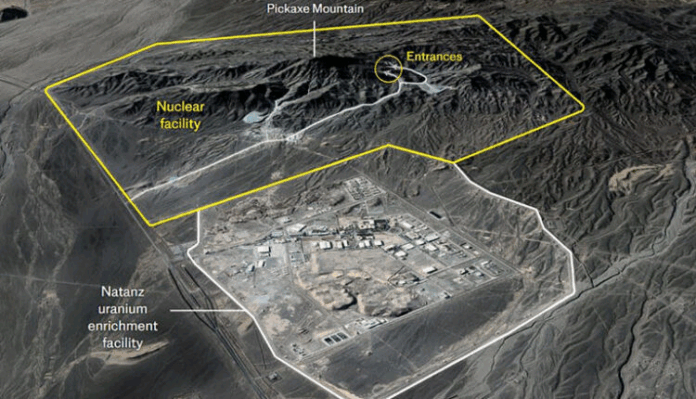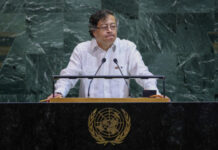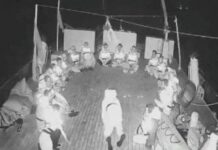Pickaxe Mountain: Iran’s secret nuclear fortress unveiled
When the director general of the International Atomic Energy Agency asked Iran to explain what was happening deep underneath Pickaxe Mountain, the reply was short and sharp: “It’s none of your business.”
Rafael Grossi’s question is more urgent now after Iran’s key enrichment facilities at Fordow and Natanz were targeted by American B-2 stealth jets armed with 30,000lb bunker-busting bombs in an attack Donald Trump claimed “obliterated” Iran’s nuclear programme.
Before the strike, 16 lorries were seen queuing up outside Fordow, and an expert on Iran’s nuclear programme told The Telegraph the regime had moved much of its highly enriched uranium to a secret location before the US was able to bomb its facilities.
Tehran had hidden sites housing “hundreds if not thousands” of advanced centrifuges capable of producing weapons-grade uranium needed for a nuclear bomb, according to Sima Shine, who has worked within the Israeli military establishment for 30 years.
According to The Telegraph, Pickaxe Mountain may be the perfect hiding place.
The sprawling site at Kūh-e Kolang Gaz Lā is 90 miles south of Fordow, and only minutes away from the Natanz nuclear facility in central Isfahan province.
The installation, which is still under construction, has been reinforced and quietly expanded in the past four years.
“Since it is obvious it is in a place where numerous and important activities related to the programme are taking place, we’re asking them, ‘What is this for?’ And they are telling us, ‘It’s none of your business,” Mr Grossi said in April.
He said it “cannot be excluded” that the tunnels would store undeclared material.
On Monday, with a renewed sense of urgency, he called for inspectors to be allowed to visit Iran’s nuclear sites in an effort to “account for” its highly enriched uranium stockpiles.
And on Tuesday, Emmanuel Macron, the French president, warned that the risk of Iran trying to enrich uranium covertly has increased twofold.
There are fears that Iran may use the shaky ceasefire with Israel that was forged by Mr Trump to do just that and build a nuclear bomb.
READ ALSO: US strikes failed to destroy Iran’s nuclear sites – Intelligence Report
“The risk has indeed increased with what has happened recently,” Mr Macron said, adding that “we must absolutely prevent Iran going down this path”.
To make matters worse, a preliminary classified US report revealed that Mr Trump’s move to bomb Iran’s nuclear sites only set Iran’s nuclear programme back by a few months.
The bombing of the nuclear sites sealed off two of the facilities, but failed to collapse their underground buildings, officials told The New York Times. With Iran still in control of most of its nuclear material, it means Iran could still make a bomb within six months, they said.
The report’s findings suggest that Mr Trump’s claim that Iran’s nuclear facilities were obliterated were oversold, based on the initial damage assessment.
On Wednesday, fears continued to grow as the Iranian parliament passed a bill to suspend its co-operation with Mr Grossi’s International Atomic Energy Agency (IAEA).
Experts have warned that Iran may be ramping up its enriched uranium production at the Pickaxe site.
Ben Taleblu, of the Foundation for Defence of Democracies, told the Financial Times: “A key question is whether Iran will, or maybe already has, secreted fissile material into Pickaxe or some other unknown facility.”
After the strikes, Iran’s potential back-up plan may lie in this ultra-secure facility that satellite imagery shows has been secretly expanded with new fortifications around what appears to be an uranium enrichment site.
While Fordow was described as the “crown jewels” of Iran’s nuclear enrichment programme, Pickaxe’s size and depth suggest facilities with significant enrichment capacity that could rival or exceed the damaged underground plant.
Fordow has two tunnel entrances, but Pickaxe Mountain has at least four – two on the eastern side of the mountain and two on the west.
More importantly, its underground chambers extend even deeper – potentially beyond 100 metres beneath the surface compared with Fordow’s 60-90 metre depth.
Experts believe the size of the project means Iran could use the facility not just to build centrifuges but also to enrich uranium. These centrifuges, set up in large groups, spin uranium gas to increase its concentration.
As of May 17, Iran had amassed 408.6kg (901lb) of uranium enriched up to 60 per cent, a report by the IAEA said. It was an increase of 133.8kg from the agency’s last report in February.
Kūh-e Kolang Gaz Lā stands 1,608 metres above sea level — more than 50 per cent taller than the 960-metre mountain housing Fordow’s centrifuge plant.
READ ALSO: US joins Israel in attacks against Iran, bombs 3 Iranian nuclear sites
The greater height provides enhanced protection and potentially larger underground chambers for nuclear operations.
Analysts estimate the facility’s depth by comparing mountain elevations with tunnel entrance heights, suggesting the complex extends far deeper underground than Fordow’s defences.
The deeper construction significantly reduces the effectiveness of bunker-buster bombs designed to penetrate underground facilities.
To target underground sites like Fordow, the US developed the GBU-57 bomb, which can penetrate at least 60 metres (200ft) of earth before exploding.
Even the massive 30,000lb bombs used against Fordow might struggle to reach targets ensconced in Pickaxe Mountain.
Reuel Marc Gerecht, resident scholar at the Foundation for Defence of Democracies, said: “The Kolang Gaz Lā or ‘Pickaxe’ mountain underground complex is intended to give the clerical regime a nuclear weapons site that even the US Air Force would have difficulty destroying with its largest conventional bombs.
“Adding tunnels and a security perimeter would further complicate any commando raid trying to sabotage the complex. Given the frequency of Israeli commando operations against Hezbollah targets, the Islamic Republic surely has anticipated these same sorts of raids on its own atomic sites.”
The original Fordow facility was built in secret and only revealed in 2009 when Western intelligence agencies declassified information showing Iran had covertly constructed the underground plant.
READ ALSO: Iran’s ‘Monster Missile’ that exposes Israel’s weakness
The discovery led to increased sanctions and became central to the 2015 nuclear deal, which required Iran to convert Fordow into a research centre and halt uranium enrichment for 15 years.
But after the US withdrew from the agreement in 2018, Iran resumed enrichment activities at the facility.
Following a 2021 explosion at Natanz that Iran blamed on Israel, Tehran accelerated enrichment at Fordow, beginning to convert uranium to 60 per cent purity — dangerously close to the 90 per cent needed for weapons.
It was also working hard down the road underneath Pickaxe mountain.
Intelligence assessments suggest Iran has been implementing a dispersal strategy for its nuclear programme, spreading capabilities across multiple sites to ensure survival in case of attack.
In recent years, Iran has deployed about 6,000 advanced centrifuges at various facilities, many of which remain inaccessible to International Atomic Energy Agency inspectors.
The Institute for Science and International Security believes Iran could “secretly deploy several thousand advanced centrifuges in the new tunnel complex” at Pickaxe mountain.
Such a capability would allow Iran to continue enrichment activities even if known facilities were destroyed.
Ali Shamkhani, an adviser to Ayatollah Ali Khamenei, Iran’s supreme leader, said: “Even assuming the complete destruction of the sites, the game is not over, because enriched materials, indigenous knowledge and political will remain intact.”
Majid Takht-Ravanchi, Iran’s deputy foreign minister, rejected claims that Tehran would abandon its nuclear programme, telling the German broadcaster ARD: “No one can tell us what we should and should not do.”
Security measures around the new mountain facility indicate Iran expects it to become operational soon.
Nuclear analysts warn that if Iran’s Islamic Republic faces what it perceives as an existential threat to regime survival, Tehran would likely abandon its public stance of pursuing only peaceful nuclear energy and rapidly move to build nuclear weapons.
READ ALSO: Devastating strikes from Iran destroy 11,000 Israeli homes, damage 30,000 others – Official
Iran and Israel have fired missiles at each other over the course of 12 days before Mr Trump took the monumental step to bomb Tehran’s nuclear programme. In response, Iran fired missiles at America’s largest and most fortified military base in the Middle East.
The Al Udeid base in Qatar, which also hosts RAF planes, came under fire from a barrage of ballistic missiles in an attack that forced the airspace to close across the Gulf.
Tensions appeared to have calmed hours later when the US president said a ceasefire between Iran and Israel had been agreed.
But as the ceasefire came into effect on Tuesday morning, Israeli jets struck targets in Iran, prompting a furious Mr Trump to phone Benjamin Netanyahu, demanding he abide by the rules.
Mr Trump later said Israel and Iran “don’t know what the f— they’re doing” as he accused both sides of violating the ceasefire agreement.
With a shaky ceasefire, and following direct US military involvement alongside Israeli attacks, Iran may conclude there’s an existential threat to its regime and build nuclear weapons rapidly.
Hardliners in Iran have already said the country must now race to produce nuclear bombs and called for attacks on US bases in the Middle East.
But Khamenei insists that he is not building a bomb and that a religious fatwa exists to prevent it from happening.
Manan Raisi, an Iranian MP, said Khamenei’s fatwa remained in place but suggested that, in Shia Islam, rulings could change “based on time and circumstances”.
Another MP, Ahmad Naderi, said: “I believe we need to conduct a nuclear bomb test, and there is no other way for us.”
The Telegraph
Follow the Neptune Prime channel on WhatsApp:
Do you have breaking news, interview request, opinion, suggestion, or want your event covered? Email us at neptuneprime2233@gmail.com





